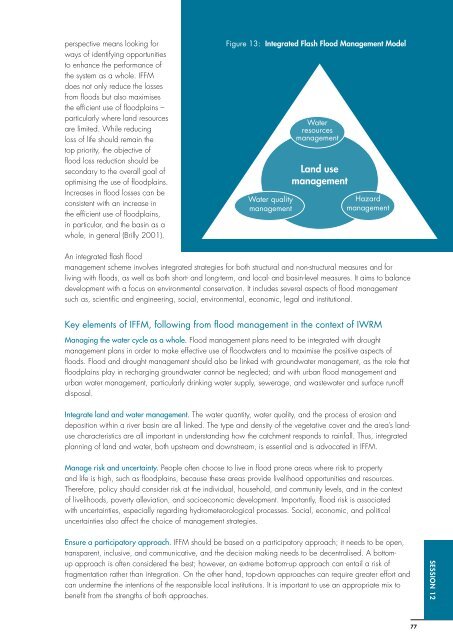Flash Flood Risk Management â A Training of Trainers ... - ReliefWeb
Flash Flood Risk Management â A Training of Trainers ... - ReliefWeb
Flash Flood Risk Management â A Training of Trainers ... - ReliefWeb
You also want an ePaper? Increase the reach of your titles
YUMPU automatically turns print PDFs into web optimized ePapers that Google loves.
Day 3<br />
perspective means looking for<br />
ways <strong>of</strong> identifying opportunities<br />
to enhance the performance <strong>of</strong><br />
the system as a whole. IFFM<br />
does not only reduce the losses<br />
from floods but also maximises<br />
the efficient use <strong>of</strong> floodplains –<br />
particularly where land resources<br />
are limited. While reducing<br />
loss <strong>of</strong> life should remain the<br />
top priority, the objective <strong>of</strong><br />
flood loss reduction should be<br />
secondary to the overall goal <strong>of</strong><br />
optimising the use <strong>of</strong> floodplains.<br />
Increases in flood losses can be<br />
consistent with an increase in<br />
the efficient use <strong>of</strong> floodplains,<br />
in particular, and the basin as a<br />
whole, in general (Brilly 2001).<br />
Figure 13: Integrated <strong>Flash</strong> <strong>Flood</strong> <strong>Management</strong> Model<br />
Water quality<br />
management<br />
Water<br />
resources<br />
management<br />
Land use<br />
management<br />
Hazard<br />
management<br />
An integrated flash flood<br />
management scheme involves integrated strategies for both structural and non-structural measures and for<br />
living with floods, as well as both short- and long-term, and local- and basin-level measures. It aims to balance<br />
development with a focus on environmental conservation. It includes several aspects <strong>of</strong> flood management<br />
such as, scientific and engineering, social, environmental, economic, legal and institutional.<br />
Key elements <strong>of</strong> IFFM, following from flood management in the context <strong>of</strong> IWRM<br />
Managing the water cycle as a whole. <strong>Flood</strong> management plans need to be integrated with drought<br />
management plans in order to make effective use <strong>of</strong> floodwaters and to maximise the positive aspects <strong>of</strong><br />
floods. <strong>Flood</strong> and drought management should also be linked with groundwater management, as the role that<br />
floodplains play in recharging groundwater cannot be neglected; and with urban flood management and<br />
urban water management, particularly drinking water supply, sewerage, and wastewater and surface run<strong>of</strong>f<br />
disposal.<br />
Integrate land and water management. The water quantity, water quality, and the process <strong>of</strong> erosion and<br />
deposition within a river basin are all linked. The type and density <strong>of</strong> the vegetative cover and the area’s landuse<br />
characteristics are all important in understanding how the catchment responds to rainfall. Thus, integrated<br />
planning <strong>of</strong> land and water, both upstream and downstream, is essential and is advocated in IFFM.<br />
Manage risk and uncertainty. People <strong>of</strong>ten choose to live in flood prone areas where risk to property<br />
and life is high, such as floodplains, because these areas provide livelihood opportunities and resources.<br />
Therefore, policy should consider risk at the individual, household, and community levels, and in the context<br />
<strong>of</strong> livelihoods, poverty alleviation, and socioeconomic development. Importantly, flood risk is associated<br />
with uncertainties, especially regarding hydrometeorological processes. Social, economic, and political<br />
uncertainties also affect the choice <strong>of</strong> management strategies.<br />
Ensure a participatory approach. IFFM should be based on a participatory approach; it needs to be open,<br />
transparent, inclusive, and communicative, and the decision making needs to be decentralised. A bottomup<br />
approach is <strong>of</strong>ten considered the best; however, an extreme bottom-up approach can entail a risk <strong>of</strong><br />
fragmentation rather than integration. On the other hand, top-down approaches can require greater effort and<br />
can undermine the intentions <strong>of</strong> the responsible local institutions. It is important to use an appropriate mix to<br />
benefit from the strengths <strong>of</strong> both approaches.<br />
session 12<br />
77

















